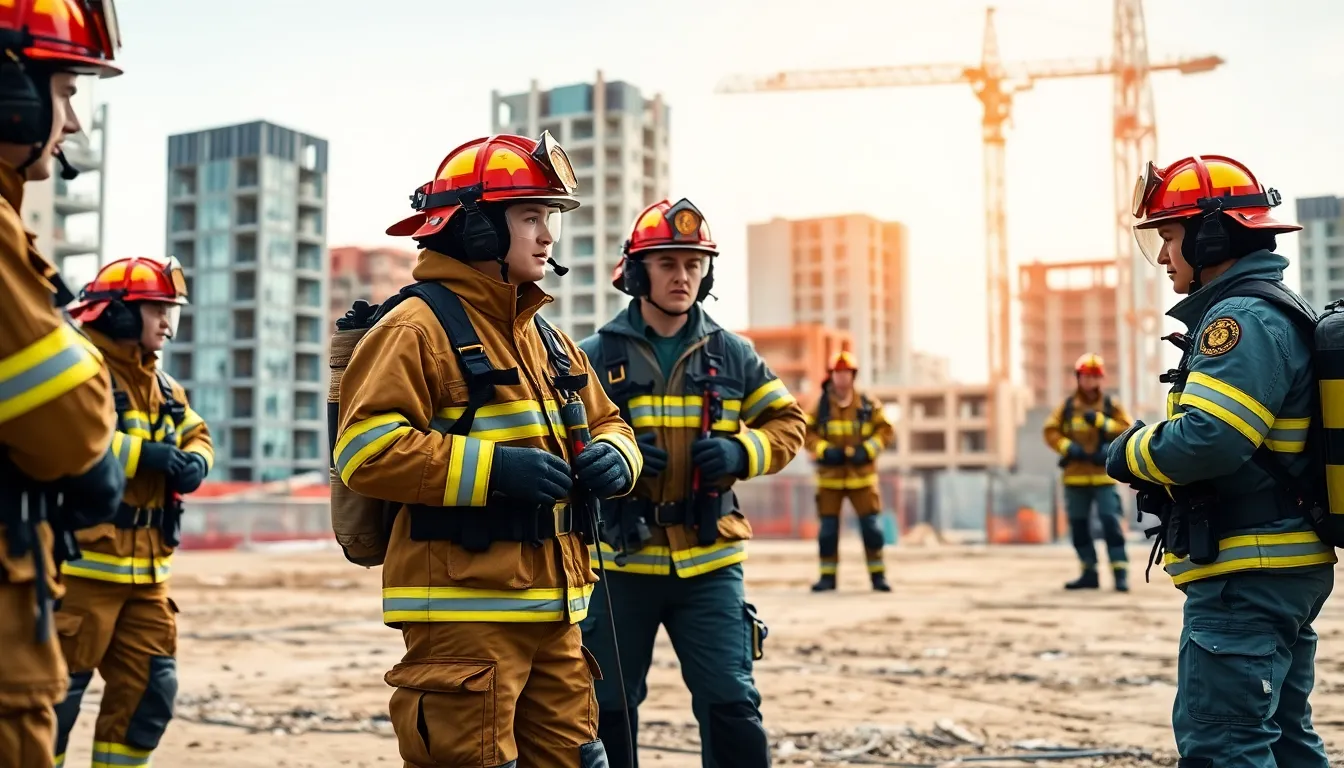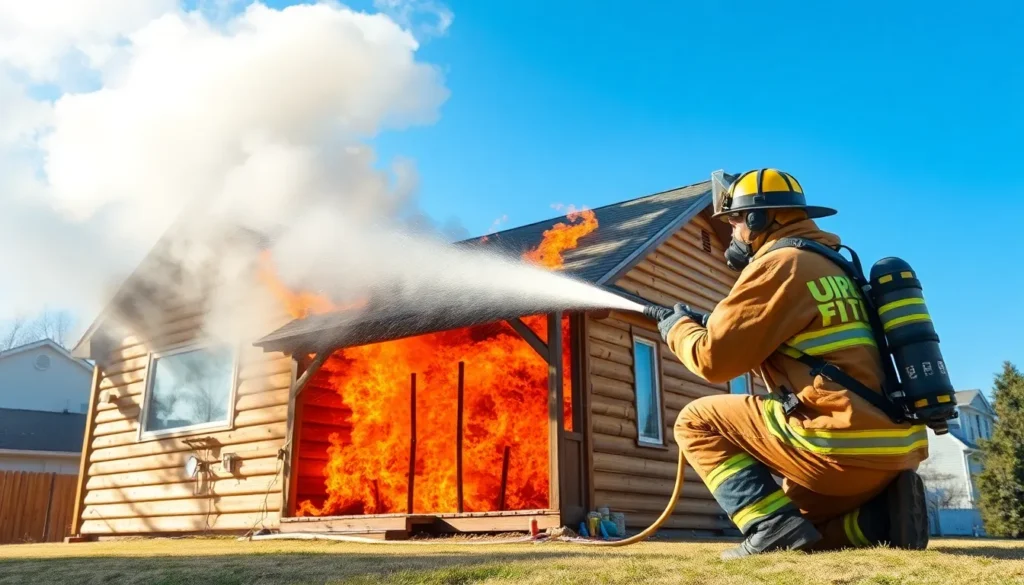When it comes to firefighting, not all buildings are created equal. Each construction type presents its own unique challenges and quirks, almost like a game of hide-and-seek with flames. Understanding these differences isn’t just for the curious—it’s crucial for safety and effective firefighting strategies. After all, you wouldn’t want to show up to a house fire armed with a squirt gun when a fire hose is needed.
From wood-frame structures that can go up faster than a pizza in a hot oven to concrete giants that stand tall against the heat, knowing what you’re dealing with is half the battle. Join us as we dive into the fascinating world of building construction types and their impact on firefighting. Whether you’re a seasoned pro or just looking to impress at the next dinner party, this guide will shed light on how these structures behave when the heat is on.
Table of Contents
ToggleOverview of Building Construction Types
Building construction types significantly influence firefighting tactics and strategies. Common types include wood-frame, heavy timber, masonry, and steel. Each type presents distinct characteristics that determine how they respond to fire.
Wood-frame construction consists of timber framing and is prevalent in residential structures. It burns quickly, creating rapid fire spread. Understanding this type is essential for firefighters, as its lightweight construction leads to a higher risk of collapse.
Heavy timber structures utilize large wooden beams, offering enhanced fire resistance compared to standard wood-frame construction. Though they burn slower, the fire can still weaken structural integrity over time. The presence of these materials requires unique firefighting approaches to manage long-lasting fires.
Masonry buildings—composed of brick or concrete—feature fire-resistant properties. They tend to contain fires within certain compartments, reducing the spread. Recognizing how masonry structures behave in fires aids firefighters in controlling situations effectively.
Steel construction, commonly found in commercial buildings, presents unique challenges. Steel can weaken under extreme heat, compromising the structure, but it won’t burn. Knowledge of when steel structures may fail is crucial for effective firefighting operations.
Each construction type demonstrates specific vulnerabilities and behaviors under fire conditions. Evaluating these factors, firefighters can implement strategies that increase safety and effectiveness during emergencies. Familiarity with these construction types equips them to handle various scenarios efficiently, improving overall firefighting efforts.
Importance of Firefighting in Construction

Firefighting plays a crucial role in construction, directly influencing safety protocols and emergency responses. Understanding building types is essential for effective fire prevention and control.
Role of Fire Safety Codes
Fire safety codes establish standards that dictate construction practices. These codes address materials, design, and occupancy, ensuring that buildings comply with safety requirements. Local regulations often vary, yet their core purpose remains to minimize fire risks. Compliance with these codes enhances safety and aids firefighters during emergencies, providing guidelines for escape routes and fire suppression systems. Regular inspections ensure adherence, making continual evaluations necessary.
Common Fire Hazards by Structure Type
Each structure type presents unique fire hazards. Wood-frame buildings ignite rapidly, leading to fast-spreading fires. Heavy timber, although more resistant, can still sustain damage under prolonged heat exposure. In masonry structures, issues often arise from flammable materials used in interiors. Steel buildings resist burning; however, structural integrity diminishes when exposed to extreme temperatures. Recognizing specific vulnerabilities allows firefighters to adapt their strategies effectively, improving overall safety during firefighting operations.
Types of Building Construction
Understanding the various building construction types is essential for effective firefighting strategies. Each type presents unique characteristics that influence fire behavior and safety.
Type I: Fire-Resistive Construction
Type I construction features materials that resist fire, such as concrete and steel. These structures typically include high-rise buildings and large commercial facilities. Fire resistance ratings often exceed two hours for elements like walls and floors. Firefighters benefit from the structural integrity of these buildings during emergencies. However, they must remain vigilant about the potential for fire spread within concealed spaces.
Type II: Non-Combustible Construction
Non-combustible construction uses materials that do not burn, such as metal and masonry. Schools and warehouses often utilize this type. While these buildings resist ignition, flammable interior finishes can still pose risks. Firefighters need to be aware of hidden fire hazards inside. Effective ventilation becomes crucial, as smoke can accumulate rapidly.
Type III: Ordinary Construction
Ordinary construction typically combines non-combustible exteriors with combustible interiors. Common examples include older commercial buildings and mixed-use residential structures. This design increases the risk of rapid fire spread due to easily ignitable materials. Firefighters may encounter challenges controlling fires in these structures. Awareness of fire behavior in this type enhances strategic planning during operations.
Type IV: Heavy Timber Construction
Heavy timber construction features large wooden beams that provide both strength and additional fire resistance. Structures like warehouses and churches often utilize this method. The substantial mass of timber can slow fire spread but still weakens under prolonged heat exposure. Firefighters must consider collapse risk while navigating these environments. They should also prepare for potential hidden fires within the timber framework.
Type V: Wood Frame Construction
Wood frame construction is common in residential neighborhoods, primarily using lightweight wood materials. This type presents a rapid ignition risk, leading to fast-spreading fires. Firefighters should respond quickly to contain potential hazards. Unique challenges arise from structures collapsing under fire exposure due to their lightweight nature. Understanding this construction type remains crucial for effective response strategies.
Firefighting Tactics for Different Construction Types
Effective firefighting tactics vary based on the construction type of a building. Understanding these differences enhances safety and efficiency during firefighting operations.
Structural Firefighting Approaches
Firefighters employ specific strategies tailored to construction types. For wood-frame buildings, quick suppression tactics are necessary due to their rapid burning nature. Heavy timber structures require careful monitoring of potential collapse, enabling teams to focus on simmering fires. Masonry buildings often involve extensive interior material assessments to address hidden fires, as firefighters can face challenges accessing different areas. Steel construction necessitates cooling efforts to protect structural integrity affected by heat, ensuring safe intervention. Recognizing these approaches helps firefighters adapt to varying situations and optimize their response.
Use of Fire Suppression Systems
Fire suppression systems play a vital role in enhancing safety across different construction types. Sprinkler systems installed in Type I structures effectively combat concealed fires, while non-combustible materials in Type II buildings may benefit from additional fire alarms to ensure early detection. Incorporating foam systems in heavy timber buildings can help manage large fires effectively, given their unique risks. Masonry buildings, with their fire-resistant properties, often utilize standpipe systems, allowing quick access for on-site firefighters. Type V wooden frame constructions frequently require comprehensive sprinkler systems to mitigate rapid ignition risks. Each system’s effective placement and maintenance are crucial for solid containment and overall safety.
Training and Preparation for Firefighters
Training and preparation play critical roles in firefighting effectiveness. Firefighters undergo extensive instruction tailored to various building construction types. They learn the unique challenges posed by wood-frame, masonry, heavy timber, and steel structures.
Hands-on drills simulate real-world scenarios in different building types. These practical exercises enhance situational awareness and response times. Firefighters practice techniques specific to each construction type, ensuring readiness for emergencies.
Moreover, training includes studying fire behavior in diverse materials. Understanding how fire spreads in wood, concrete, and steel informs tactical decisions. Each material’s response to heat influences suppression strategies, maximizing effectiveness during incidents.
Preparation encompasses familiarization with local building codes. These codes dictate design and materials, directly impacting firefighting plans. Firefighters gain insights into escape routes and potential hazards present in various structures.
Physical conditioning remains essential for firefighters. Stamina and strength improve performance during strenuous operations, especially in challenging environments. Team collaboration also enhances efficiency, ensuring seamless coordination during firefighting efforts.
Regular updates on equipment and firefighting technology ensure that firefighters remain current in their methods. Training sessions incorporate new tools and procedures as they emerge. Firefighters benefit from continuous education, refining skills to adapt to evolving fire situations.
Moreover, psychological preparedness fosters resilience. Stress management techniques enable firefighters to handle the demands of intense situations. Emphasizing mental well-being promotes effective decision-making during emergencies.
Ultimately, robust training and preparation form the backbone of successful firefighting strategies. Familiarity with building construction types, fire behavior, and emergency protocols shapes capable first responders. This comprehensive approach builds a foundation for efficient firefighting in diverse scenarios.
Understanding building construction types is crucial for effective firefighting. Each type presents unique challenges that demand tailored strategies for successful fire control and safety. Firefighters must be aware of how materials respond to heat and the specific vulnerabilities of each structure to mitigate risks effectively.
With proper training and knowledge of fire safety codes, firefighters can enhance their response tactics, ensuring better protection for both themselves and the public. Continuous education and hands-on experience remain vital in adapting to the complexities of various construction types. Ultimately, a well-informed firefighting approach contributes significantly to minimizing fire hazards and improving overall safety in emergency situations.





